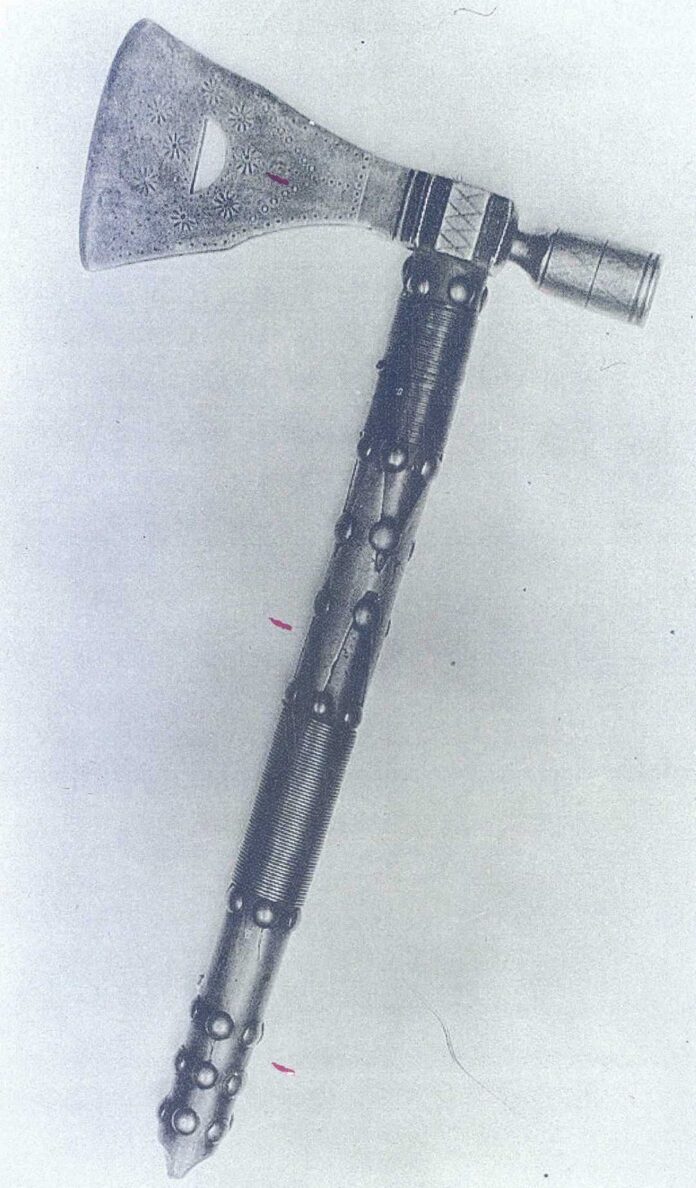You know that classic scolding and have probably caught yourself repeating it to your own kids: “Don’t run around with those scissors, or somebody’s gonna get hurt!” I wonder if any Native American moms similarly admonished their warrior sons. Those boys grew into men who ran into battles with their favorite weapon in hand, the tomahawk, and usually somebody did get hurt.
By 1812, the Native Americans had already been trading for years with the white man to gain better weaponry. They still used the bow and arrow and knives, and were now accumulating their share of muskets; but they always had a special fondness for the tomahawk, or uh, the hatchet.
I can’t be the only one who mixes up those two terms. Are they interchangeable? Well, a few people throughout history have loosely used either name to describe any number of similar-appearing instruments. Today, when referring to a hatchet, it’s the one always having a slightly curved handle that is no more than a foot long. It sports a wedge-shaped metal head with a blade on one side and often a hammer head on the other. Many simply have a ring (or poll) that slips over the wooden shaft. The Native Americans and some frontiersmen used the hatchet more often as a tool than a weapon, but it was both.
The tomahawk design took the hatchet concept to the next level. I mean, there are bicycles and then there are Harleys, right? The name alone, tomahawk, has become synonymous with awesomeness. Even our most sophisticated cruise missiles, the ones that could target a squirrel from hundreds of miles away, carry the same appellation because in the right hands they are a precision weapon — with a ton of swagger.
The combination of a long, straight wooden handle and a weighted head made the Native American tomahawk a device that could strike an enemy swiftly and accurately. It was still the preferred weapon for close combat during the War of 1812 battles, as is historically evident in numerous paintings.
Tomahawks were not just constructed, however; they were crafted. The Native Americans embellished the wooden handles with exquisite carvings and ornamentation. They traded for the forged heads, which blacksmiths often beautifully engraved in meticulous detail. The side of the head opposing the blade took many shapes, such as a spike or hammer, but a pipe bowl was most popular — making these tomahawks not only instruments of war, but of peace.
Deliberations between white men and Native Americans were often concluded with the pipe/tomahawk being passed amongst them. The handle actually had a hole drilled its entire length and the inhaling end was variously tapered. Though stories abound, it would be wrong to assume that anything more robust than tobacco was lit in these pipes on formal occasions such as treaty signings. The pipe-smoking ceremony was actually religious in nature and tobacco was a sacred element. The smoke symbolized prayers wafting up to the Great Spirit, not unlike the Catholic practice of lighting candles. The use of hallucinogens in these situations would have been profane.
Some tomahawks were created strictly as grand gifts. Col. Henry Proctor, leader of the British forces throughout our Northwest Territory, presented the great Tecumseh, for his allegiance to the crown, a beautiful pipe/tomahawk engraved along the blade, “To Chief Tecumseh, From Col. Proctor, MDCCCXII.”
Tecumseh was known to reciprocate this gift-giving toward his white friends. In 1807, he presented then governor of Ohio, Thomas Worthington, a magnificent tomahawk which is still on display at Worthington’s Adena mansion, in Chillicothe, Ohio. Closer to home, John Waggoner, one of the first settlers of Fremont, Ohio, and the fourth great-grandfather of current Toledo resident Mr. Jay Waggoner, also received a Tecumseh tomahawk before the war broke out. John Waggoner served with the American forces at Fort Meigs in 1813 against his friend, but that gift has survived 200 years and was recently donated by the family to the Rutherford B. Hayes Presidential Center in Fremont. Adena and the Hayes Center are two great, history-laden day trips.
Frank Kuron is author of the War of 1812 book, “Thus Fell Tecumseh.” Email him at
kuronpubs@bex.net
Bugle Call: Upcoming events
- The Wolcott House Museum Guild continues sponsoring free history lectures about our region at 10 a.m. Thursdays through March at the Maumee Branch Library Auditorium, 501 River Road.
- The Western Lake Erie Region during the War of 1812 will be the focus of the annual Friends of Pearson March Sunday Series, at 2 p.m. each week in Macomber Lodge at Pearson Metropark. Upcoming sessions include: March 18, when Daniel Downing, education and operations chief at the River Raisin National Battlefield, will discuss the famous battle at the Monroe battlefield; and March 25, when local historian and author Larry Michaels will conclude the series with a session about Northwest Ohio’s best-known explorer, Peter Navarre, who played a role in the war.

























